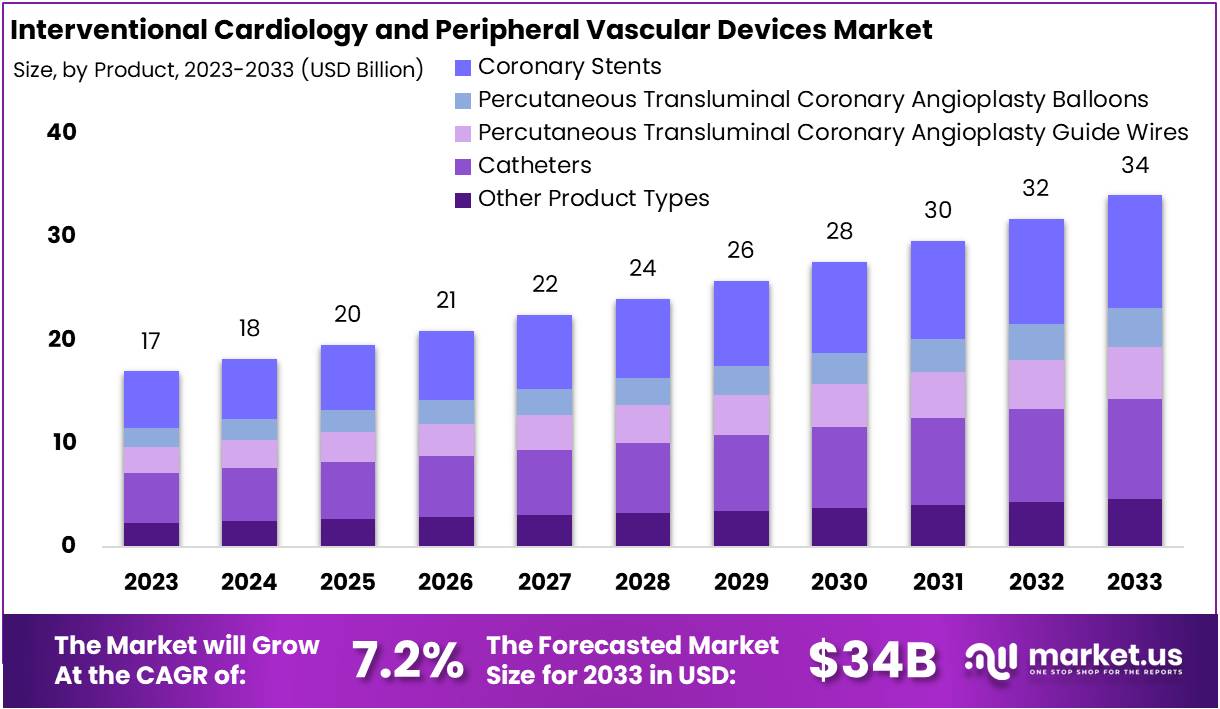Introduction
The Global Interventional Cardiology and Peripheral Vascular Devices Market is projected to double from USD 17 billion in 2023 to USD 34 billion by 2033, growing at a CAGR of 7.2%. This growth is fueled by advancements in medical technology, such as the development of minimally invasive devices like stents and catheters. These innovations enable more efficient treatments for complex cardiovascular conditions with reduced patient downtime and lower risks compared to traditional surgeries.
One significant development is the broader adoption of Transcatheter Aortic Valve Replacement (TAVR). Initially used for high-risk patients, TAVR is now expanding to lower-risk groups, bolstered by improvements that minimize complications like stroke. This adaptation underscores the procedure’s enhanced safety and effectiveness, contributing to its increased utilization.
Additionally, the sector is paying greater attention to Peripheral Artery Disease (PAD), focusing on early detection and comprehensive management to prevent severe outcomes such as limb amputation. Multidisciplinary strategies incorporating lifestyle modifications, exercise rehabilitation, and psychotherapy are vital for improving patient quality of life and managing this condition more effectively.
Compounded by an aging global population and rising cardiovascular disease rates, there is an escalating demand for interventional cardiologists. This demand highlights the need for continuous training and development to mitigate the shortage of specialists and ensure preparedness for future healthcare challenges. The interventional cardiology and peripheral vascular devices sector is poised for substantial growth, driven by technological progress and strategic disease management approaches.

Key Takeaways
- The market is expected to reach USD 34 billion by 2033, with a CAGR of 7.2% from 2024 to 2033.
- Coronary Stents hold a 32% share in 2023, essential for treating heart conditions.
- Hospitals are the primary end-users, holding over 42% market share in 2023, with Ambulatory Surgical Centers following.
- The growing elderly population increases demand, as they are more prone to heart diseases.
- Stringent regulations lengthen product development, raising costs and delaying launches.
- Digital advancements in healthcare, such as remote monitoring and AI, are enhancing patient care.
- North America leads with a 37% market share in 2023, supported by superior healthcare systems and favorable government policies.
- Emerging markets present significant growth potential, fueled by economic development and increased cardiovascular disease awareness.
- Demand for minimally invasive procedures rises with Congenital Heart Defect Correction leading application segments.
- Continuous innovations in interventional cardiology and vascular devices are boosting patient outcomes and market expansion.
Emerging Trends
Rise of Non-Invasive Diagnostic Tools
Non-invasive diagnostic methods are becoming more common in assessing blood vessel blockages. These techniques help minimize patient discomfort and reduce risks linked to invasive procedures. Advanced tools such as computed tomography angiography (CTA) and magnetic resonance angiography (MRA) offer clearer imaging without the need for catheterization. Physicians prefer these techniques as they lower the chances of complications like bleeding and infections. Moreover, these approaches help in early diagnosis, allowing for timely interventions. The growing demand for patient-friendly diagnostic solutions is pushing the industry toward developing safer and more efficient non-invasive methods. As these technologies improve, they will likely become the standard in vascular diagnostics.
Advancements in Imaging Technologies
Innovations in imaging are improving the detection and treatment of vascular diseases. Forward-looking ultrasound catheters, intravascular ultrasound (IVUS), and optical coherence tomography (OCT) are gaining popularity. These technologies provide real-time, high-resolution images of blood vessels, helping doctors identify blockages more accurately. Improved imaging leads to better treatment planning and reduces procedural errors. Moreover, AI-driven imaging tools are emerging, offering automated analysis and faster diagnosis. As hospitals and clinics adopt these technologies, they enhance the effectiveness of vascular interventions. The integration of advanced imaging in interventional cardiology is expected to improve patient outcomes and procedural success rates significantly.
Growing Popularity of Bioresorbable Stents
Bioresorbable stents are becoming a game-changer in vascular treatments. Unlike traditional metal stents, these stents dissolve naturally in the body over time. This reduces the risks of long-term complications such as stent thrombosis and vessel scarring. Patients benefit from improved artery function without the permanent presence of foreign material. Researchers are working on improving the durability and effectiveness of these stents. Current designs use bioresorbable polymers that provide structural support before gradually breaking down. With clinical trials showing promising results, bioresorbable stents are expected to gain wider acceptance. Their adoption could redefine long-term vascular care and patient safety.
Expansion of Drug-Eluting Stents (DES)
Drug-eluting stents (DES) are increasingly used in coronary and peripheral artery disease treatments. These stents release medication that prevents artery re-narrowing, reducing the need for repeat procedures. Compared to bare-metal stents, DES significantly lowers the risk of restenosis. Modern DES are designed with thinner struts and improved polymer coatings, enhancing drug delivery and reducing complications. Researchers are also developing biodegradable coatings to further minimize side effects. The widespread use of DES is helping improve long-term patient outcomes. As technology advances, next-generation drug-eluting stents will likely offer even greater benefits in treating complex vascular conditions.
Shift Toward Transradial Access Procedures
Transradial access is gaining preference over traditional femoral artery access in interventional cardiology. This approach involves inserting catheters through the wrist rather than the groin. It is associated with fewer complications, such as bleeding and arterial damage. Patients experience faster recovery times, and many can be discharged the same day. This method also improves patient comfort, making it a preferred choice for both doctors and patients. Studies show that transradial access has lower mortality rates in high-risk patients undergoing heart procedures. As hospitals continue to adopt this approach, it is set to become the standard for many cardiovascular interventions.
Use Cases
Coronary Artery Disease Treatment
Drug-eluting stents help open narrowed heart arteries, reducing the risk of heart attacks. These stents release medication to prevent artery re-narrowing, improving long-term outcomes. Patients with blocked coronary arteries often experience chest pain or shortness of breath. Stenting restores blood flow, easing symptoms and enhancing quality of life. The procedure is minimally invasive, requiring only a small incision. Compared to open-heart surgery, it offers a faster recovery. Many patients return to normal activities within days. Physicians recommend stents for those with significant artery blockages. Lifestyle changes and medications support long-term success. Regular check-ups ensure the stents remain effective.
Peripheral Artery Disease Management
Angioplasty and atherectomy restore blood flow in narrowed peripheral arteries. These procedures help patients with leg pain due to restricted circulation. Angioplasty uses a small balloon to widen the artery, while atherectomy removes plaque buildup. Both treatments reduce symptoms like cramps and fatigue. Improved blood flow prevents complications such as ulcers and infections. Patients regain mobility and experience less discomfort during daily activities. Minimally invasive techniques ensure shorter recovery times. Doctors recommend these treatments for moderate to severe cases. Combining these procedures with medications improves long-term outcomes. Regular monitoring helps detect any recurrence of blockages early.
Carotid Artery Stenosis Intervention
Stenting procedures treat carotid artery narrowing, reducing stroke risk. The carotid arteries supply blood to the brain, and blockages can lead to serious complications. A stent is placed to keep the artery open, preventing future strokes. This procedure is an alternative to traditional surgery. Patients with high stroke risk benefit from stenting. The treatment is minimally invasive, requiring only local anesthesia. Recovery is quick, and most patients resume normal activities within days. Stenting lowers stroke risk in those with severe carotid artery disease. Doctors monitor patients regularly for any changes. Lifestyle adjustments and medications support long-term artery health.
Renal Artery Stenosis Treatment
Angioplasty treats narrowing in renal arteries, helping control high blood pressure. Blocked kidney arteries can cause hypertension and organ damage. A small balloon is used to widen the artery, restoring blood flow. This improves kidney function and prevents further complications. Patients with resistant hypertension often need this treatment. The procedure is minimally invasive, reducing hospital stay time. Many patients experience better blood pressure control after treatment. Regular follow-ups ensure artery health and prevent re-narrowing. Combining angioplasty with medication enhances long-term benefits. Early detection of renal artery issues is key to successful treatment.
Regional Analysis
In 2023, North America dominated the Interventional Cardiology and Peripheral Vascular Devices Market, holding over 37% market share with a value of USD 6.2 billion. This growth is due to a strong healthcare infrastructure and high awareness of cardiovascular diseases. The region has a large patient population requiring these procedures, driving demand for advanced devices. The presence of top healthcare institutions and medical technology companies further strengthens the market. These factors create a favorable environment for innovation and adoption of cutting-edge cardiology and vascular devices.
Technological advancements continue to play a crucial role in market expansion. Leading research institutions and healthcare providers work together to develop and implement new interventional devices. The increasing adoption of minimally invasive procedures also drives demand. North America benefits from strong clinical research, supporting rapid approval and commercialization of new products. The presence of multinational device manufacturers ensures continuous product development. As healthcare providers prioritize precision treatments, the region remains a hub for next-generation cardiovascular technologies.
Government support and reimbursement policies further boost the market. Public healthcare programs in the U.S. and Canada provide favorable coverage for interventional cardiology. This encourages hospitals to invest in advanced medical equipment. Additionally, public-private partnerships contribute to better access to cutting-edge treatment options. Regulatory frameworks promote stringent safety and efficacy standards, ensuring market stability. With strong investment in healthcare infrastructure, North America continues to be a leader in peripheral vascular and cardiology device innovations.
Looking ahead, the market is expected to maintain steady growth. Factors such as the rising prevalence of cardiovascular diseases and ongoing technological advancements will sustain demand. Investment in AI-driven diagnostics and robotic-assisted procedures will further transform the landscape. However, regulatory changes and increasing competition may present challenges. Market players must stay proactive, focusing on strategic collaborations and product innovations to capitalize on emerging opportunities. By leveraging these trends, North America will remain a key player in the global interventional cardiology market.
Conclusion
The Interventional Cardiology and Peripheral Vascular Devices Market is set for steady expansion, driven by advancements in minimally invasive procedures, improved diagnostic tools, and a growing patient population. The increasing adoption of drug-eluting stents, bioresorbable stents, and transradial access techniques highlights the industry’s shift toward safer and more effective treatments. Emerging markets present growth opportunities, while North America remains a leader due to strong healthcare infrastructure and innovation. The demand for advanced cardiovascular care continues to rise, supported by government policies and technological progress. With ongoing research and product development, the market will evolve to enhance patient outcomes, making interventional cardiology a key area in modern healthcare advancements.
Discuss your needs with our analyst
Please share your requirements with more details so our analyst can check if they can solve your problem(s)



